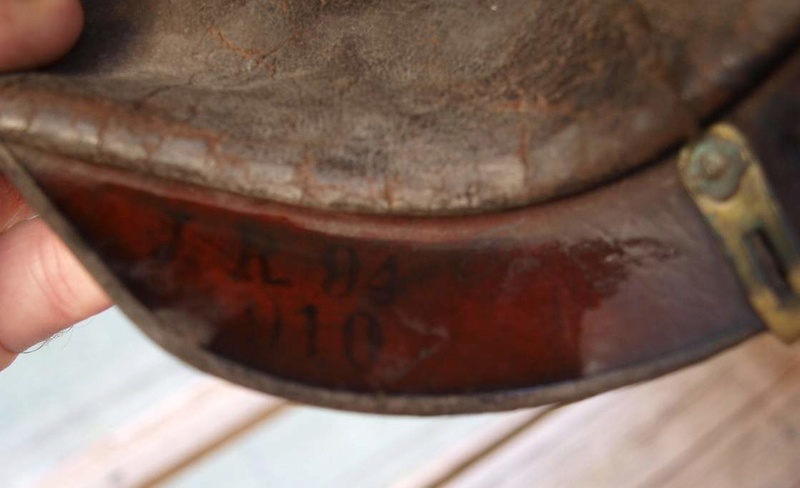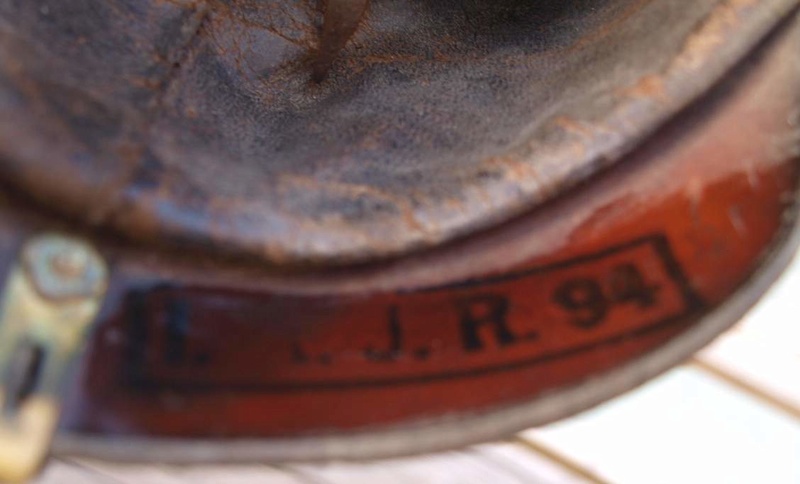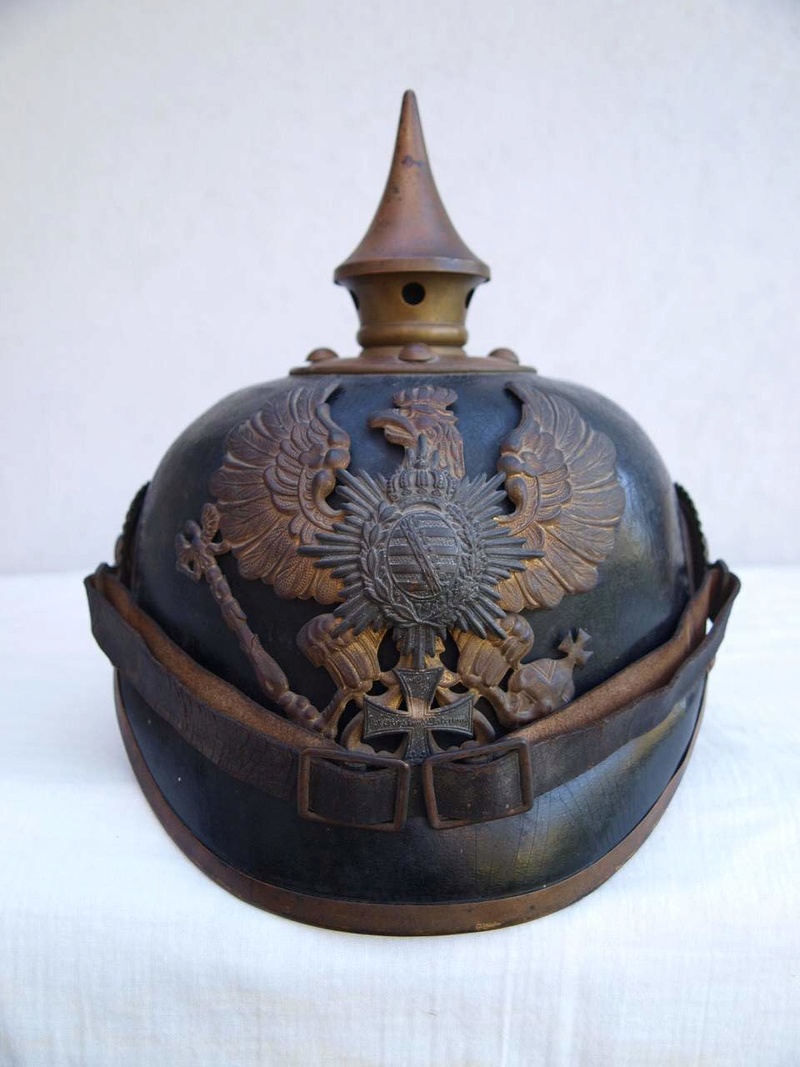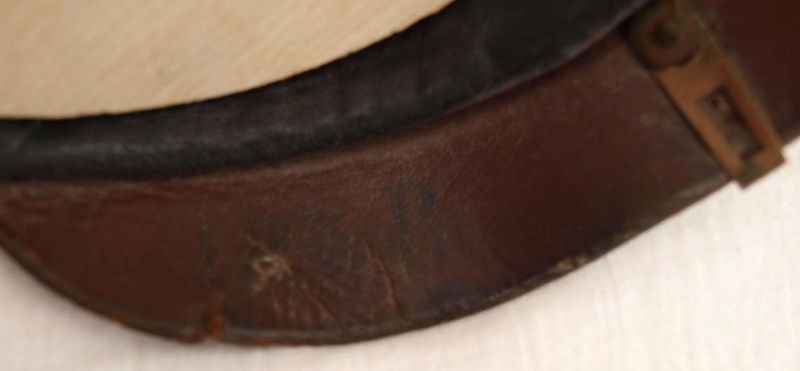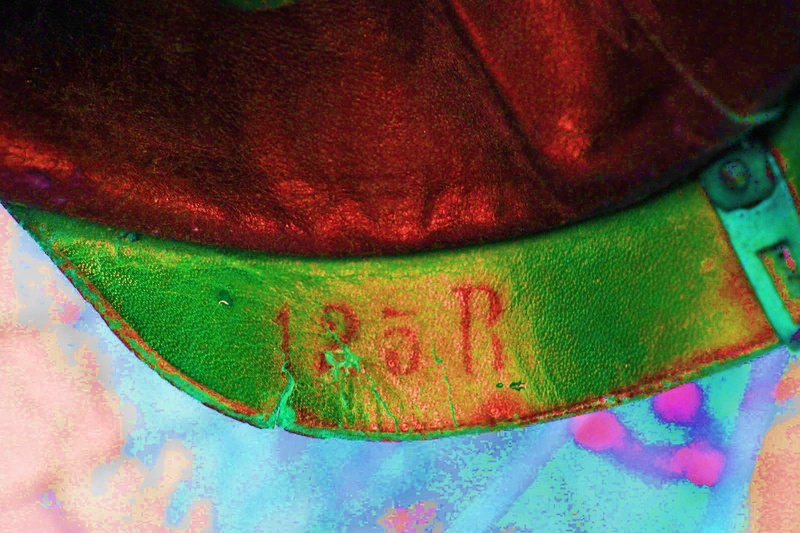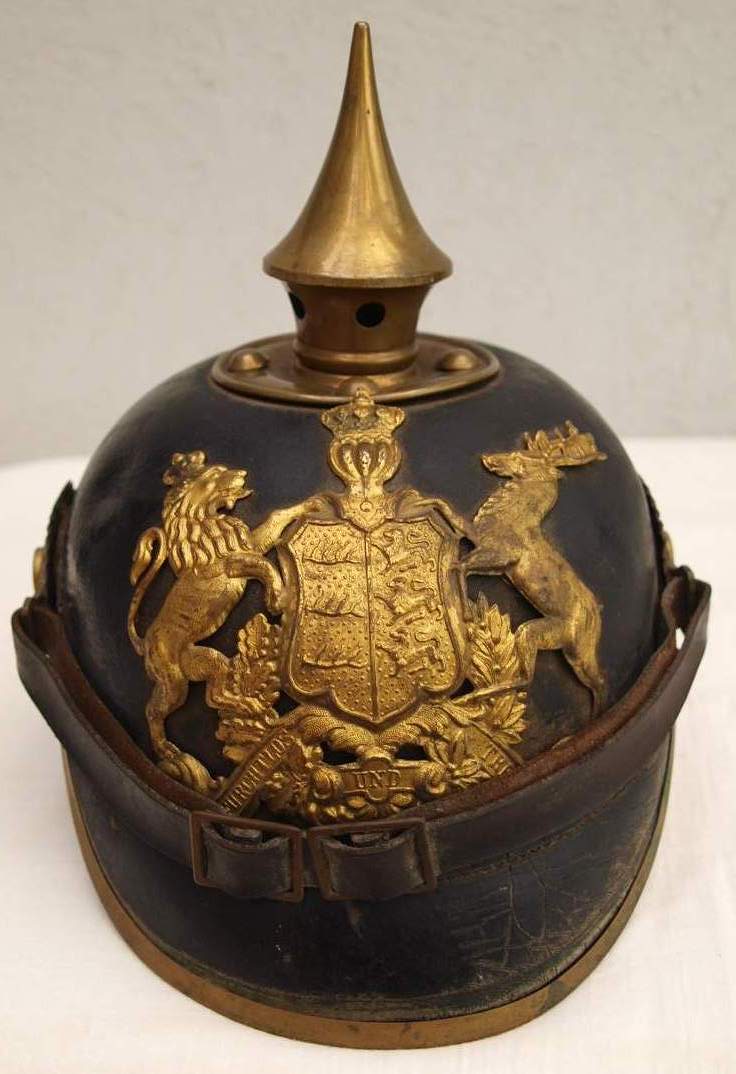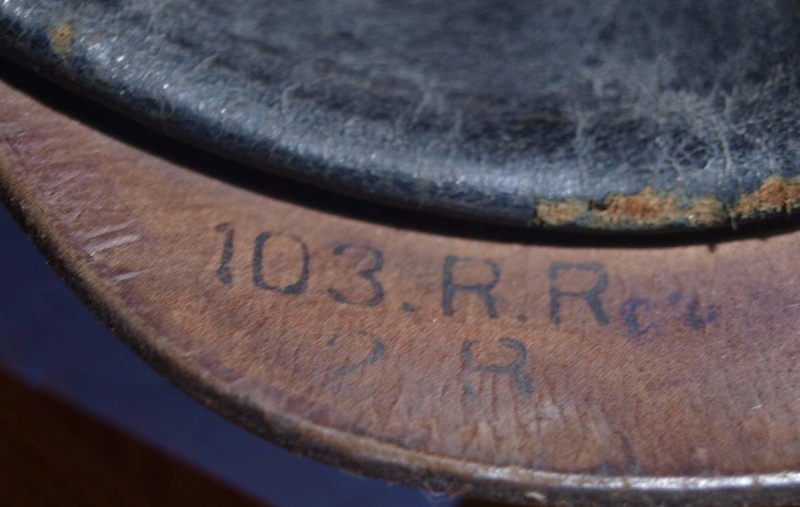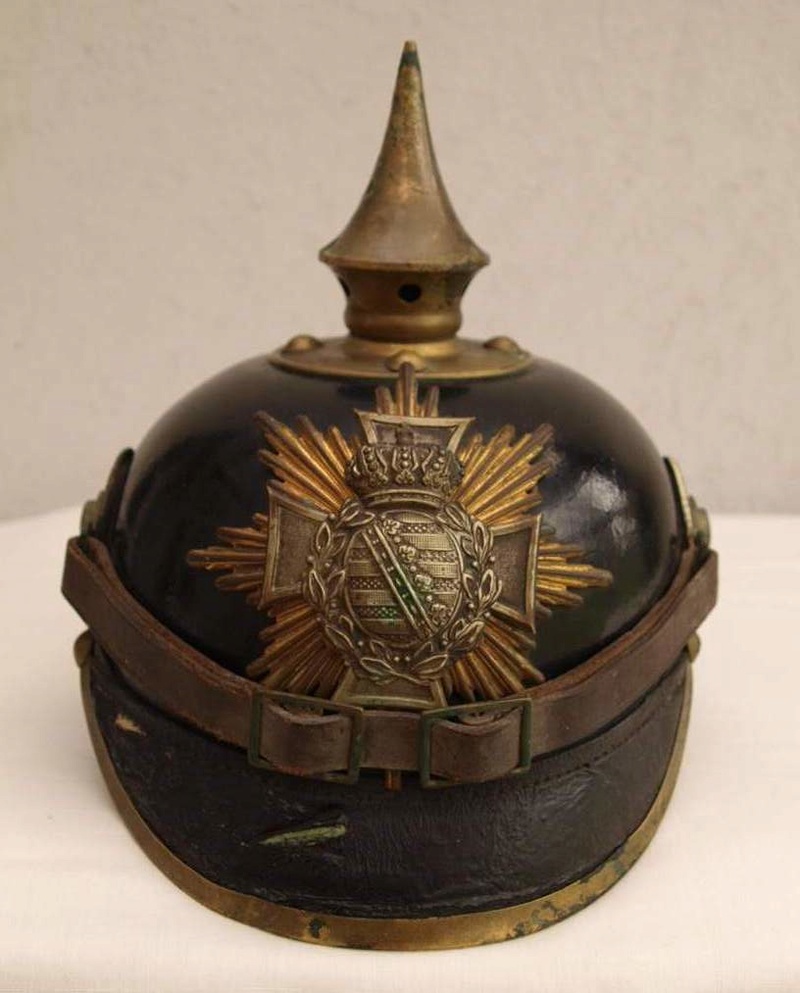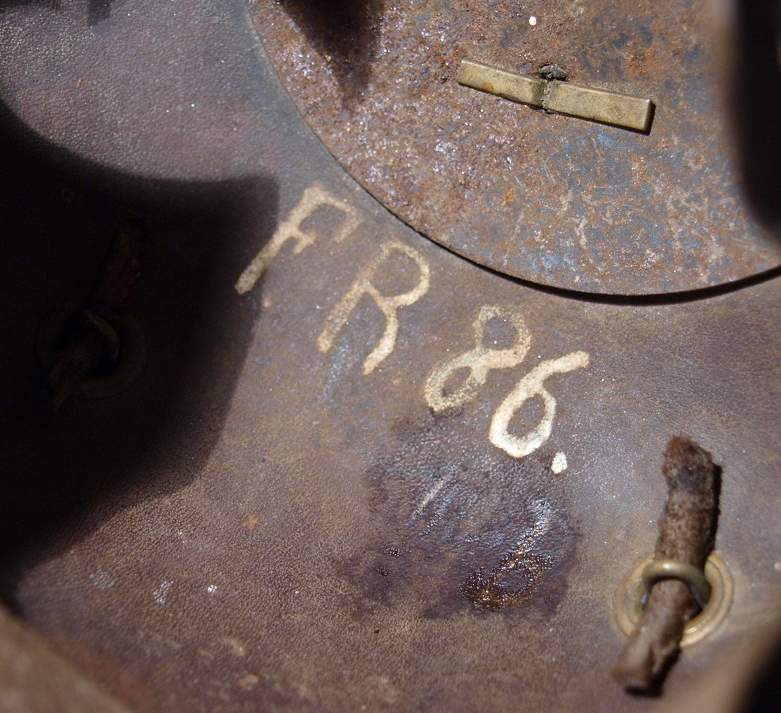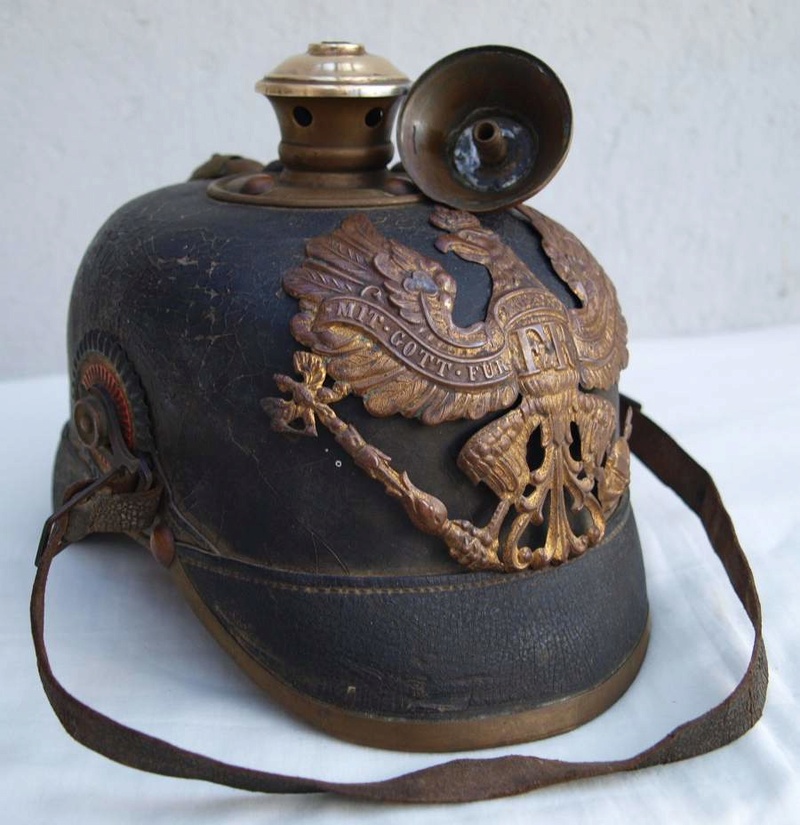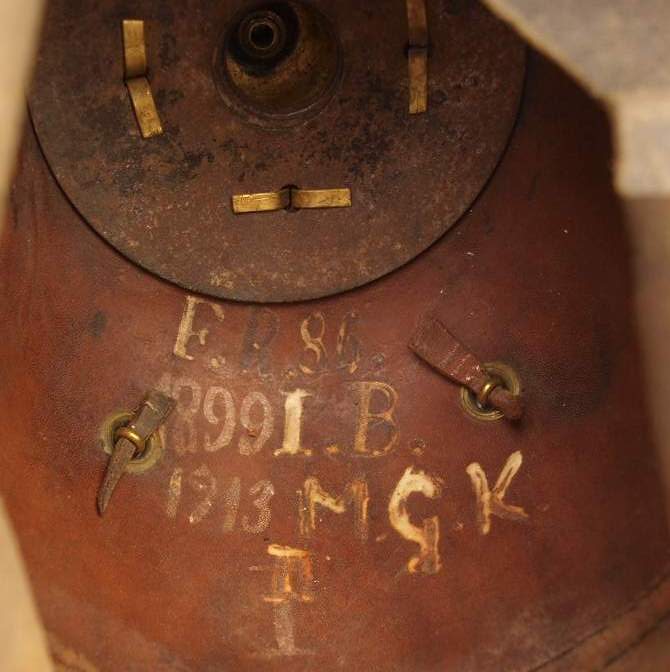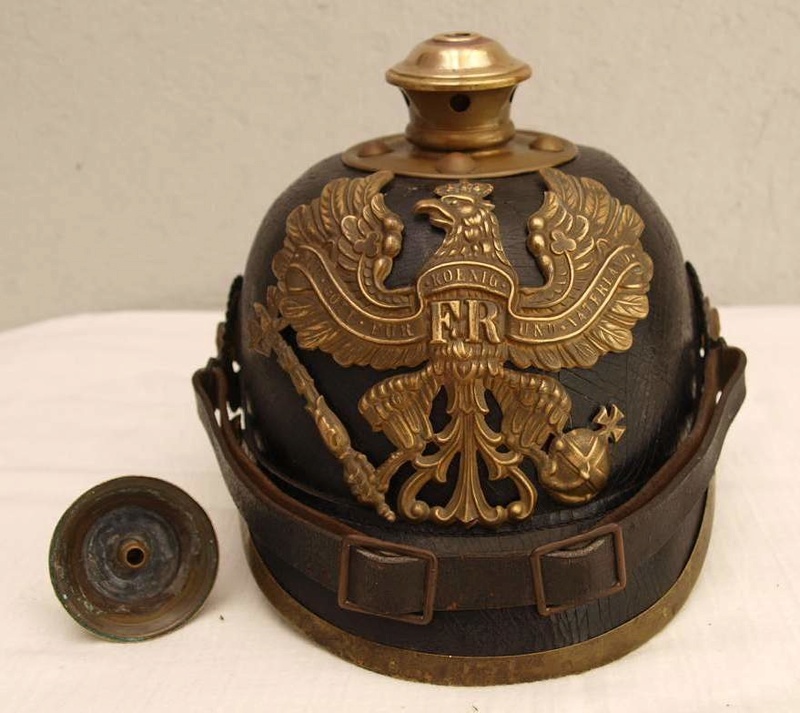You are using an out of date browser. It may not display this or other websites correctly.
You should upgrade or use an alternative browser.
You should upgrade or use an alternative browser.
A few regimental stamps more for the list
- Thread starter argonne
- Start date
Here is another reserve JR94 (Sachsen-Weimar), Philippe, remarkable by the huge reserve cross. The whole eagle plate is big and heavy; probably an older model recycled for the M95. The helmet is marked to R29, which as you know hosted reservists from JR94 in its IIIrd battalion. Another marking in a rectangle is not legible. There are also two names: Tarcher B., on the rear bill and inside the shell, and Gefreiter Bohne (Boehne) close to the spike fixation...
View attachment 4
View attachment 3
View attachment 2
View attachment 1
View attachment 4
View attachment 3
View attachment 2
View attachment 1
argonne
Well-known member
Bruno,
Your helmet is interesting! The name TARCHER does not bring any results, no such name in the whole german lists. I presume this was a guy who wore this helmet during peace time, long time before the mobilisation.
But......Interestingly, your helmet has been assembled from a lot of old parts to be given in the urgence to a reservist or a Landwehrmann at the mobilisation. It has the emblem of Saxe-Weimar-Eisenach, but it is the wrong emblem for this old helmet of the JR32 (Meiningen) which formed august 1914 the I/RJR71 in Meiningen. I am sure that the stamp that you can not read is: I.B R.J.R.71 The emblem should have the laurel leaves on both sides of the saxon center (Saxe-Altenburg and Saxe-Coburg-Gotha). But as this helmet has been assembled in this period of helmet shortage, no problem for me about its 100% authenticity for this kind of helmets of the small duchies.
It is perfectly matching with the second name in the helmet: Gefreiter RÖHNER, born Juli 1882, from the first company. I tracked him in the lists: Gefreiter der Landwehr August RÖHNER from the 1. company RJR71 (IB), missing during the fights between the 8 and 24.9.1914 at Ormoy, Droiselles, Lombray, Cuts, Nouvron and Morsain (Aisne).
http://des.genealogy.net/search/show/637620
But a second publication of 1918 is telling that this guy died in captivity:
http://des.genealogy.net/search/show/8125000
And we find him at the Red Cross. It is told there, that he was wounded and then missed on the 13.9.14 during the fight at Channy and Nouvron near Reims:
https://grandeguerre.icrc.org/fr/File/Details/311935/1/2/
Obviously he has then been taken prisonner and died a few days later in captivity.
Philippe
:wink:
Your helmet is interesting! The name TARCHER does not bring any results, no such name in the whole german lists. I presume this was a guy who wore this helmet during peace time, long time before the mobilisation.
But......Interestingly, your helmet has been assembled from a lot of old parts to be given in the urgence to a reservist or a Landwehrmann at the mobilisation. It has the emblem of Saxe-Weimar-Eisenach, but it is the wrong emblem for this old helmet of the JR32 (Meiningen) which formed august 1914 the I/RJR71 in Meiningen. I am sure that the stamp that you can not read is: I.B R.J.R.71 The emblem should have the laurel leaves on both sides of the saxon center (Saxe-Altenburg and Saxe-Coburg-Gotha). But as this helmet has been assembled in this period of helmet shortage, no problem for me about its 100% authenticity for this kind of helmets of the small duchies.
It is perfectly matching with the second name in the helmet: Gefreiter RÖHNER, born Juli 1882, from the first company. I tracked him in the lists: Gefreiter der Landwehr August RÖHNER from the 1. company RJR71 (IB), missing during the fights between the 8 and 24.9.1914 at Ormoy, Droiselles, Lombray, Cuts, Nouvron and Morsain (Aisne).
http://des.genealogy.net/search/show/637620
But a second publication of 1918 is telling that this guy died in captivity:
http://des.genealogy.net/search/show/8125000
And we find him at the Red Cross. It is told there, that he was wounded and then missed on the 13.9.14 during the fight at Channy and Nouvron near Reims:
https://grandeguerre.icrc.org/fr/File/Details/311935/1/2/
Obviously he has then been taken prisonner and died a few days later in captivity.
Philippe
:wink:
argonne
Well-known member
About the five helmets above, yes, they are all battlefield pickups, all untouched and left as they were. And they all have the name of wearer in them.
- The RJR94 helmet (barn find) has been taken on a german soldier in Droiselles-Rozières during a fight with french cavalry on the 9.9.14.
- The JR125 Württemberg helmet(from an old collection in Baden Württemberg) belong to a Vize-Feldwebel which has been killed in action near the Delville Wood (Somme) on the 18.8.1916.
- The RJR103(recent barn find) saxon helmet has been taken during the battle of the Marne on a german wounded soldier at Vassimont on the 12.9.14, after the fight at Sommesous (8 and 9.14). The saxon soldier was left wounded on the battlefield, because the regiment had to retreat quickly to the north after the Marne desaster.
- both FR86 helmets has been taken the same day, the 6.6.15 during the first day of the terrible Quennevières battle near Moulin sous Touvent (Picardie). On this day, 10000 french soldiers (Zouaves, Algérians and soldiers from Morbihan / Bretain) took the three german trench lines in less than one hour. There were in this small sector only 1000 soldiers of one german bataillon, the III/FR86. 600 of them are still missing, 250 were taken prisoners and the rest could retreat, mostly wounded. The Zouaves and Algerians made a massacre on this black day....
One of this helmet with the chinstrap still in combat position (recent barn find near the city of Tours) has been taken on a dead german. His body has never been found. The second helmet has been brought back by an ambulance man from Britain on a wounded young soldier (only 18 years old). The ambulance man was after the war a pharmacist in Britain (Morbihan). A family piece from the granddaughter of the ambulance man. She also was pharmacist, has retired and is now living in Corsica.
Philippe
:wink:
- The RJR94 helmet (barn find) has been taken on a german soldier in Droiselles-Rozières during a fight with french cavalry on the 9.9.14.
- The JR125 Württemberg helmet(from an old collection in Baden Württemberg) belong to a Vize-Feldwebel which has been killed in action near the Delville Wood (Somme) on the 18.8.1916.
- The RJR103(recent barn find) saxon helmet has been taken during the battle of the Marne on a german wounded soldier at Vassimont on the 12.9.14, after the fight at Sommesous (8 and 9.14). The saxon soldier was left wounded on the battlefield, because the regiment had to retreat quickly to the north after the Marne desaster.
- both FR86 helmets has been taken the same day, the 6.6.15 during the first day of the terrible Quennevières battle near Moulin sous Touvent (Picardie). On this day, 10000 french soldiers (Zouaves, Algérians and soldiers from Morbihan / Bretain) took the three german trench lines in less than one hour. There were in this small sector only 1000 soldiers of one german bataillon, the III/FR86. 600 of them are still missing, 250 were taken prisoners and the rest could retreat, mostly wounded. The Zouaves and Algerians made a massacre on this black day....
One of this helmet with the chinstrap still in combat position (recent barn find near the city of Tours) has been taken on a dead german. His body has never been found. The second helmet has been brought back by an ambulance man from Britain on a wounded young soldier (only 18 years old). The ambulance man was after the war a pharmacist in Britain (Morbihan). A family piece from the granddaughter of the ambulance man. She also was pharmacist, has retired and is now living in Corsica.
Philippe
:wink:
argonne said:Bruno,
Your helmet is interesting! The name TARCHER does not bring any results, no such name in the whole german lists. I presume this was a guy who wore this helmet during peace time, long time before the mobilisation.
But......Interestingly, your helmet has been assembled from a lot of old parts to be given in the urgence to a reservist or a Landwehrmann at the mobilisation. It has the emblem of Saxe-Weimar-Eisenach, but it is the wrong emblem for this old helmet of the JR32 (Meiningen) which formed august 1914 the I/RJR71 in Meiningen. I am sure that the stamp that you can not read is: I.B R.J.R.71 The emblem should have the laurel leaves on both sides of the saxon center (Saxe-Altenburg and Saxe-Coburg-Gotha). But as this helmet has been assembled in this period of helmet shortage, no problem for me about its 100% authenticity for this kind of helmets of the small duchies.
It is perfectly matching with the second name in the helmet: Gefreiter RÖHNER, born Juli 1882, from the first company. I tracked him in the lists: Gefreiter der Landwehr August RÖHNER from the 1. company RJR71 (IB), missing during the fights between the 8 and 24.9.1914 at Ormoy, Droiselles, Lombray, Cuts, Nouvron and Morsain (Aisne).
http://des.genealogy.net/search/show/637620
But a second publication of 1918 is telling that this guy died in captivity:
http://des.genealogy.net/search/show/8125000
And we find him at the Red Cross. It is told there, that he was wounded and then missed on the 13.9.14 during the fight at Channy and Nouvron near Reims:
https://grandeguerre.icrc.org/fr/File/Details/311935/1/2/
Obviously he has then been taken prisonner and died a few days later in captivity.
Philippe
:wink:
Very impressive, Philippe! Many thanks for such an interesting story. My initial interpretation was different: knowing that some of the reserve of IR94 was in RJR32, I assumed naively that "R32" stood for "Reserve 32", as can be seen occasionally, but your tracking of Gefreiter Roehner to RJR71 leaves no doubt: he was from the Sachsen-Coburg-Gotha contingent, and not from Sachsen-Weimar. Indeed, a bunch of laurel leaves did not make a big difference on the eagle plate, and these small saxon duchies were known for their lose adhesion to some regulations. We all know this picture in Larcade's book were 20 infantry men from Sachsen-Weimar IR94 wear 10 different spike helmet models...
In conclusion, my helmet should wear a green/white/green cockade, and not the IR94 cockade I adorned it with... correct?
argonne
Well-known member
911car said:In conclusion, my helmet should wear a green/white/green cockade, and not the IR94 cockade I adorned it with... correct?
"Should", Bruno, should.... #-o
I think we will never know that exactly, because this authentic veteran helmet is breaking the rules on the whole line with its big reserve cross and its Sachsen-Weimar-Eisenach frontplate on a JR32 - I/RJR71 Meiningen helmet. It has maybe never have worn a Land cockade, or simply a prussian one, or even maybe a green/white/green of the three small saxon duchies.....Or a saxon one....All was then possible....
Things that were regular in peace time had no importance anymore as 2 millions men had to be urgently dressed in a very few days...Some german reservists even wore old fire departments helmets....
Philippe
:wink:
joerookery
Well-known member
Thank you for the stamps! I will try to get to it this weekend. The cockade colors are quite confusing for this grand Duchy:
Saxe-Weimar-Eisenach
(1813-1871: Sachsen-Weimar-Eisenach)
The Grand Duchy of Saxe-Weimar-Eisenach, a German state in Thuringia since 1566, was a member state of the German Confederation from 1815 to 1866. The Saxe-Weimar family was the oldest branch of the Ernestine line, and therefore, the entire House of Saxony. It was the largest of the Thuringian states, and comprised the three detached districts of Weimar, Eisenach, and Neustadt, along with twenty-four scattered enclaves. In 1877, it officially changed its name to the Grand Duchy of Saxony (Großherzogtum Sachsen), but this name is rarely used in modern sources. In 1896, the order of the colors for the flag and the cockades was changed to black-yellow-green. Prior to that time, the color order was black-green-yellow. After the Austro-Prussian War, when it allied with Prussia, it became a member state of the North German Confederation in 1867. The Saxe-Weimar-Eisenach military became a contingent of the Prussian army on 26 June 1867. It became a member state of the German Empire in 1871.
I once had an active JR 94 that had the old colors on the cockade. It had been reissued during the 1914 call up but it appeared as though some of the fittings had been replaced.
RIR 71 formed by IR 32, IR 167
RIR 94 mobilized by IR 94
Saxe-Weimar-Eisenach
(1813-1871: Sachsen-Weimar-Eisenach)
The Grand Duchy of Saxe-Weimar-Eisenach, a German state in Thuringia since 1566, was a member state of the German Confederation from 1815 to 1866. The Saxe-Weimar family was the oldest branch of the Ernestine line, and therefore, the entire House of Saxony. It was the largest of the Thuringian states, and comprised the three detached districts of Weimar, Eisenach, and Neustadt, along with twenty-four scattered enclaves. In 1877, it officially changed its name to the Grand Duchy of Saxony (Großherzogtum Sachsen), but this name is rarely used in modern sources. In 1896, the order of the colors for the flag and the cockades was changed to black-yellow-green. Prior to that time, the color order was black-green-yellow. After the Austro-Prussian War, when it allied with Prussia, it became a member state of the North German Confederation in 1867. The Saxe-Weimar-Eisenach military became a contingent of the Prussian army on 26 June 1867. It became a member state of the German Empire in 1871.
I once had an active JR 94 that had the old colors on the cockade. It had been reissued during the 1914 call up but it appeared as though some of the fittings had been replaced.
RIR 71 formed by IR 32, IR 167
RIR 94 mobilized by IR 94

